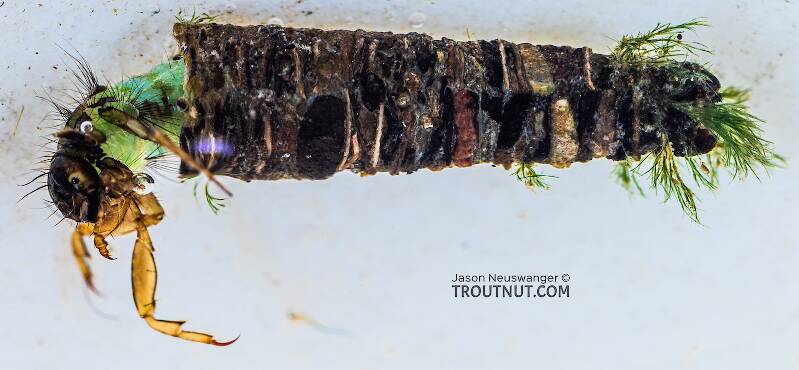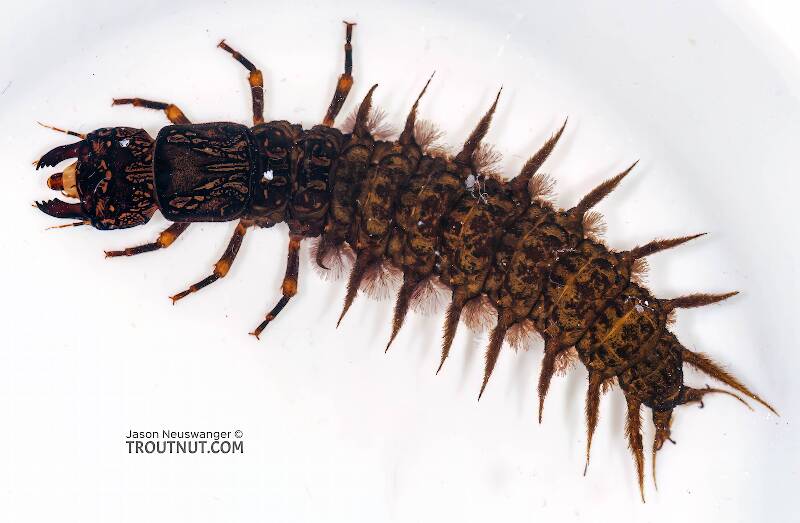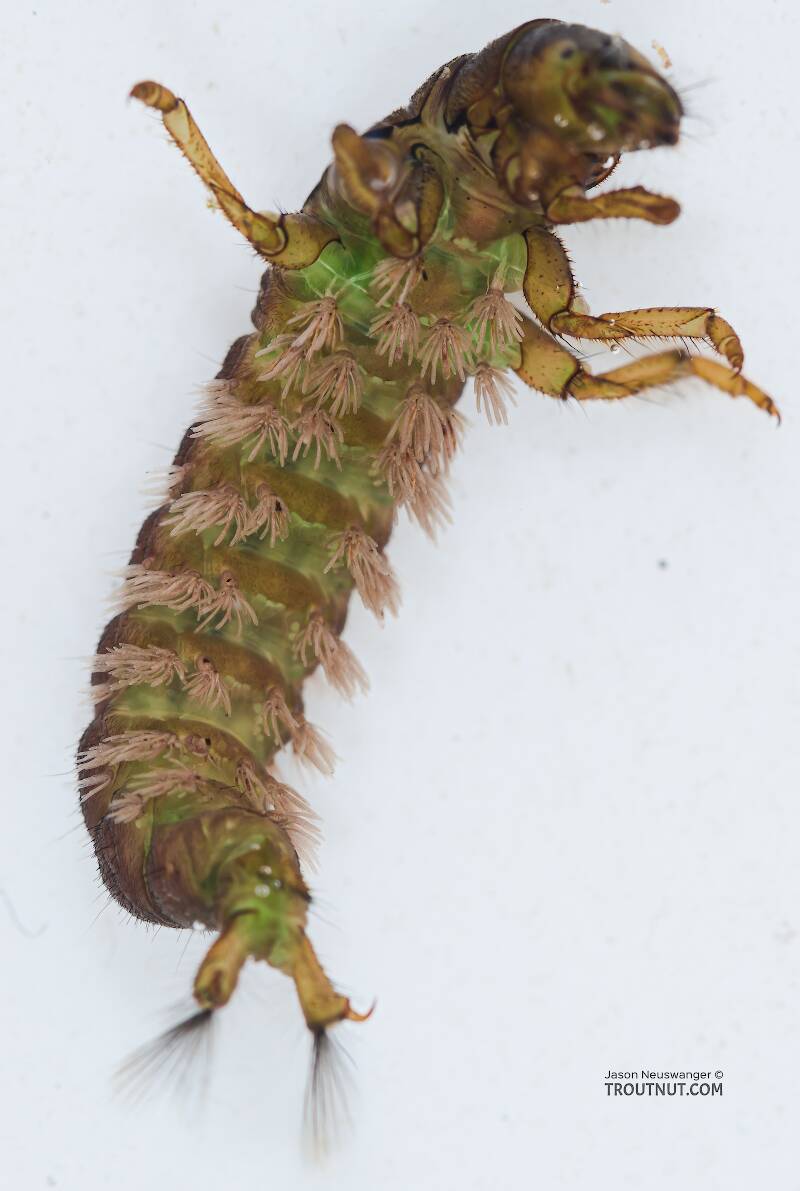
Blue-winged Olives
Baetis
Tiny Baetis mayflies are perhaps the most commonly encountered and imitated by anglers on all American trout streams due to their great abundance, widespread distribution, and trout-friendly emergence habits.
Featured on the forum

I caught this tiny larva without a case, but it seems to key pretty clearly to to Glossosomatidae. From there, the lack of sclerites on the mesonotum points to either Glossosoma or Anagapetus. Although it's difficult to see in a 2D image from the microscope, it's pretty clear in the live 3D view that the pronotum is only excised about 1/3 of its length to accommodate the forecoxa, not 2/3, which points to Glossosoma at Couplet 5 of the Key to Genera of Glossosomatidae Larvae.

Troutnut is a project started in 2003 by salmonid ecologist Jason "Troutnut" Neuswanger to help anglers and
fly tyers unabashedly embrace the entomological side of the sport. Learn more about Troutnut or
support the project for an enhanced experience here.
Identification: Key to Orders of Aquatic Insect Larvae and Wingless Adults
Identification: Key to Orders of Aquatic Insect Larvae and Wingless Adults
Error: Tried to access a key that isn't live.
Adapted from Merritt R.W., Cummins, K.W., and Berg, M.B. (2019)
This first couplet rules out a different class (Collembola rather than Insecta), but it's included here because Collembola (Springtails) superficially look like insects and are often collected alongside aquatic insects.
| Option 1 | Option 2 |
|---|---|
| Abdomen with 6 or fewer segments and a ventral tube | Abdomen with more than 6 segments and without a ventral tube |
| Body tiny, 5 mm or less | Body size variable, often > 5 mm |
| Most with a forked structure (furcula) at tip of abdomen | |
| Remaining orders: Coleoptera, Diptera, Hemiptera, Hymenoptera, Lepidoptera, Megaloptera, Neuroptera, and Trichoptera | |
5 Example Specimens | |
| Collembola | Go to Couplet 2 |
Adapted from Merritt R.W., Cummins, K.W., and Berg, M.B. (2019)
The current couplet is highlighted with darker colors and a icon, and couplets leading to this point have a icon.
Couplet 1 (You are here)
Leads to Collembola:
- Abdomen with 6 or fewer segments and a ventral tube
- Body tiny, 5 mm or less
- Most with a forked structure (furcula) at tip of abdomen
Leads to Couplet 2:
- Abdomen with more than 6 segments and without a ventral tube
- Body size variable, often > 5 mm
Couplet 2
Leads to Couplet 3:
- Three pairs of jointed legs on thorax
Couplet 3
Leads to Couplet 8:
- True legs absent; fleshy, leg-like protuberances or prolegs may be present on thorax, but fewer than three pairs and not jointed
Couplet 8
Leads to Lepidoptera:
- Abdomen with at least 2 pairs (usually 5 pairs) of ventral, fleshy, leg-like protuberances tipped with tiny hooks (prolegs with crochets)
Leads to Couplet 5:
- Abdomen without paired, ventral, leg-like protuberances, or, if present, not tipped with tiny hooks
Couplet 5
Leads to Trichoptera:
- Last abdominal segment with lateral appendages bearing sclerotized, hook-like anal claws
- Antennae 1-segmented, inconspicuous
- Gills, if present, seldom confined to lateral margins of body
- Larvae frequently live in cases made of sand grains or bits of plant matter, but some are free-living
Leads to Couplet 6:
- Last abdominal segment without anal claws
- If anal claws present, antennae have more than 1 segment
- Gills inserted laterally
Couplet 6
Leads to Neuroptera:
- Mandibles and maxillae united at each side to form long, straight or slightly recurved, thread-like suctorial tubes
- Laterally inserted, segmented gills folded beneath abdomen
- Small, 10 mm or less Found in or on freshwater sponges
Neuroptera
Leads to Couplet 7:
- Mandibles not united with maxillae into long tubes; if mandibles suctorial, then strongly curved, sickle-shaped
- Gills seldom segmented and not folded beneath abdomen
Couplet 7
Leads to Megaloptera:
- Abdomen with 7-8 pairs of lateral filaments or gills, arranged 1 pair on each segment
- Paired terminal anal prolegs each with 2 claws or a single, medial, caudal filament
Leads to Coleoptera:
- Abdomen usually without lateral gills; if segmental gills present, then (a) only a single terminal anal proleg with 4 claws, otherwise anal hooks absent, or (b) segment 10 with 4 gills, or (c) caudal appendages paired or absent but never single
Leads to Couplet 9:
- Head capsule distinct, partly or entirely hardened, and usually pigmented, but may be deeply withdrawn in prothorax
Couplet 9
Leads to Couplet 10:
- Head capsule absent, not distinct, hardened, or pigmented, often consisting of a few pale rods
Couplet 10
Leads to Diptera:
- Posterior end of body with at least one or a combination of gills, hair brushes, a sucker, or breathing tube
Leads to Coleoptera:
- Posterior end of body simple or with small processes or isolated hairs, but without gills, brushes, suckers, or breathing tubes
Leads to Diptera:
- Body often 5 mm or larger, elongate, somewhat cylindrical, spindle-shaped or maggot-like
- Mouthparts may be reduced to a pair of retractile mouth hooks that move vertically
Leads to Hymenoptera:
- Body usually 5 mm or less
- Mouthparts may be reduced to a pair of opposable, acute mandibles that move horizontally
- Parasitoids on or inside insect hosts
Start a Discussion of this Couplet
References
- Merritt R.W., Cummins, K.W., and Berg, M.B. 2019. An Introduction to the Aquatic Insects of North America (Fifth Edition). Kendall/Hunt Publishing Company.
Orders excluded
These orders of Insecta are not included in this key: Ephemeroptera, Plecoptera, Odonata-Anisoptera, Odonata-Zygoptera, Orthoptera, Psocodea






